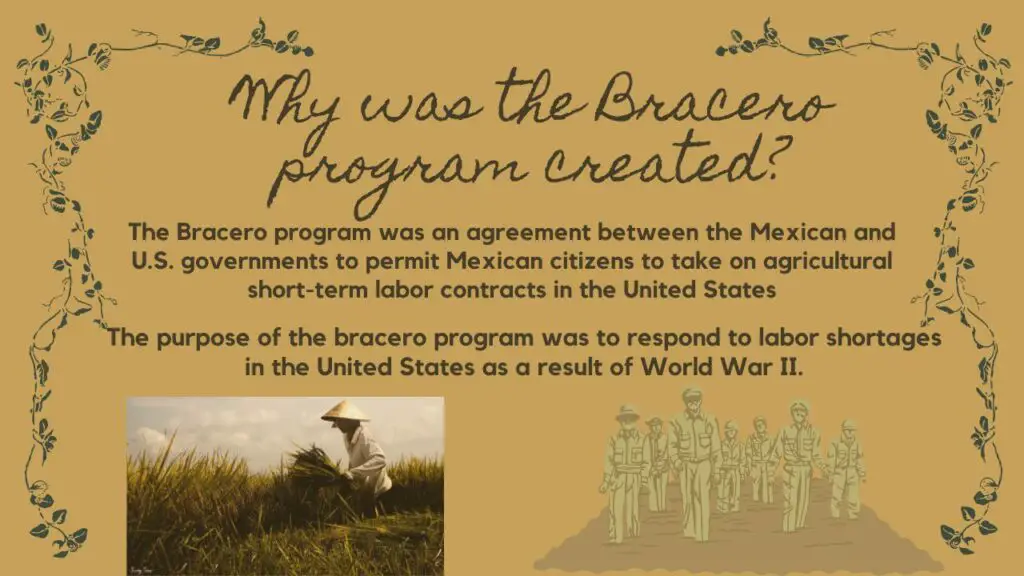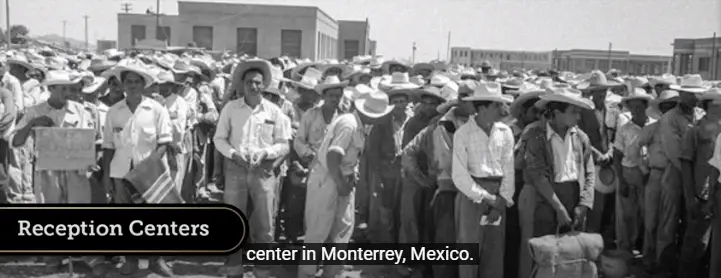Why was the Bracero program created? The Bracero Program was a bilateral, contract labor program created between Mexico and the United States. Between 1942 and 1964, the program brought between 4 – 5 million Mexican laborers to the United States. The majority of the migrants worked in the agricultural industry while a few worked in railroads.
The United States government brought Mexican workers into the country on temporary, short-term contracts and this program happened to be the start of increased migration, both legal and illegal, from Mexico to the United States. In this article, we aim to answer the question of why the Bracero program was created and how it worked.

Related: Effects of the industrial revolution
What was the Bracero program and the reason for its creation?
The Bracero program also known as the Mexican Farm Labor Program was the result of a series of agreements between the United States and Mexico in response to the demand for agricultural labor during World War II. It was created by presidential executive order in 1942, and the program contracted with nearly 500,000 Mexicans to work in the United States from 1942 to 1947.
During World War II, the U.S. government negotiated with the Mexican government to form the bracero program in order to recruit Mexican workers (all men but without their families) to work on short-term contracts on farms and in other war industries. Even after the war, the bracero program continued in agriculture until 1964. Nationally, the program continued until December 31, 1964, with nearly 4.5 million Mexican citizens making the journey during the program’s twenty-two-year existence.
The Mexican workers that were recruited by the U.S. government were called braceros because they worked with their arms and hands (coined from a Spanish word). The bilateral agreement under the bracero program guaranteed prevailing wages, health care, and adequate housing. The program assured the braceros of decent living conditions such as food, adequate shelter, and sanitation, as well as a minimum wage of 30 cents an hour. The braceros were to receive free health care, housing, and transportation back to Mexico when their contracts expired.
The braceros were also guaranteed protections from forced military service and a part of their wages was to be put into a private savings account in Mexico. All these enticements and offers that came with the program prompted thousands of unemployed Mexican workers to join the Mexican Farm Labor Program. The program lasted 22 years and offered employment contracts to 4-5 million braceros in 24 U.S. states which was the largest foreign worker program in U.S. history.

Source: Youtube
The braceros were either family men that left their families behind or single men. They helped the United states sustain agricultural production during the war and were essential in maintaining railroad lines for the transportation of goods, people, and war materials. Therefore, through these efforts, the braceros were a significant part of the Allied war effort. They entered the United States under six-month to twelve-month contracts and were assigned to regions throughout the country. However, once their contract expired, they were required to return to Mexico and sign another contract in order to return back to the United States to work.
Although the Bracero program was meant to guarantee a minimum wage, housing, and health care, there was little enforcement to ensure that these workers were treated humanely. Also, the bracero program created a large pool of cheap labor that held down farm wages for American workers.
See also: Positive effects of the industrial revolution
Why was the Bracero program created?
The bracero program was mainly created in response to the labor shortages that occurred in the United States during World War II. There were so many Americans in the military during this period and farmers worried that they would not have enough agricultural labor to meet their needs. Therefore, in response to this, the U.S. and Mexican governments negotiated a series of agreements creating the bracero program to allow Mexican laborers to come as agricultural workers to the United States on short-term contracts.
To solve labor shortages during World War II
Why was the Bracero program created? The labor shortages that occurred during World war II were one of the major reasons why the Bracero program was created. This shortage of labor led the U.S. government to negotiate with the Mexican government to recruit Mexican workers to work on short-term contracts in U.S. agriculture and in other war industries. They recruited only males into the bracero program without their families. After the war, the braceros were restricted to agriculture, as the Mexican and U.S. governments renegotiated the terms of the program several times.
To help Mexicans and their economy
There were certain reasons why the Mexican government agreed to the bracero program in the first place. First, the Mexican government wanted Mexican citizens to learn new agricultural skills that they could bring back to the country to enhance crop production in Mexico. Hence, the braceros participated in the program in the belief that becoming braceros temporarily would enable them to acquire additional skills and knowledge while earning something higher than what was available in Mexico.
Second, the Mexican government expected Mexican workers to bring the money they earned back to Mexico, in order to help stimulate the country’s economy. However, in practice, many of the Mexican workers became trapped in cycles of working for higher wages in harsh manual labor agricultural jobs in the United States.
The cost of the bracero program, employers’ abuse, and the corrupt practices of officials led many Mexicans to seek work illegally in the United States. They readily found employment with U.S. agricultural conglomerates and other employers that sought workers for lower wages.
A chance for the U.S. government to make up for the repatriations in the 1930s
The bracero program was also created as a chance for the U.S. government to make up for some of the repatriations that occurred in the 1930s. Since the Mexican Revolution (1910–20), Mexico as a country had been experiencing political, social, and economic problems. As a result, many Mexican citizens immigrated to the United States and even helped support the U.S. economy during World War I (1914–18).
The unemployment rate rose drastically in the United States after the Great Depression began in 1929 and many U.S. citizens blamed Mexican workers for taking jobs that they felt were meant for Americans. This led to mounting unrest and a number of Mexican immigrants voluntarily returned to Mexico. Local and state authorities, in some cases, even began repatriation campaigns to return immigrants, including the ones that were legal U.S. citizens. It is estimated that in the 1930s, about 400,000 -1,000,000 Mexicans and Mexican Americans were forced out of the United States or left voluntarily.
However, with the onset of World War II (1939–45), a record number of Americans entered military service, while the workers left at home switched to the better-paying manufacturing jobs that were suddenly available. Hence, the U.S. was once again in need of extra workers as there were not enough workers to take on agricultural and other unskilled jobs. Hence, in order to meet this need, the U.S. entered an agreement with the Mexican government and created the Bracero Program. The creation of this program was therefore a chance for the U.S. government to make up for the repatriations of Mexicans that occurred in the 1930s.
Check out: How did the Industrial Revolution Change Society?
Conclusion
Why was the Bracero program created? The Bracero program was an agreement between the Mexican and U.S. governments to permit Mexican citizens to take on agricultural short-term labor contracts in the United States. The purpose of the bracero program was to respond to labor shortages in the United States as a result of World War II.
Having so many Americans in the military made farmers worry that they would not have enough agricultural labor to meet their needs. Hence, the U.S. and Mexican governments negotiated a series of agreements and developed the bracero program which was to protect Braceros from poor wages and discrimination as they work for the U.S. government. However, despite the promises from the U.S. government, braceros still suffered discrimination and racism in the United States.
However, despite the problems of the bracero program, it persisted until 1964, when labor and civil rights reformers successfully pressured its termination. The bracero program came to an end in 1964 because of concerns about the program being abused and the maltreatment of the Bracero workers.
Last Updated on November 3, 2023 by Nansel Nanzip BongdapObotu has 2+years of professional experience in the business and finance sector. Her expertise lies in marketing, economics, finance, biology, and literature. She enjoys writing in these fields to educate and share her wealth of knowledge and experience.
